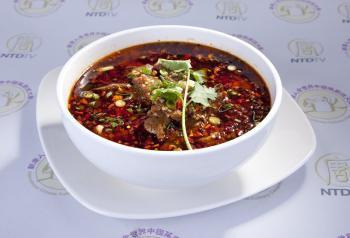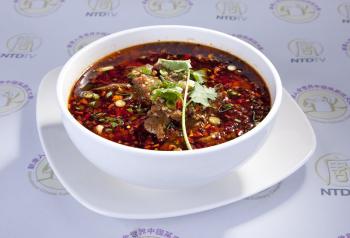NEW YORK—The Final Round of the International Chinese Culinary Competition was held on Monday at the Lighthouse in Chelsea Piers. The event, put on by satellite station New Tang Dynasty TV (NTDTV), is meant to promote understanding of true traditional Chinese cuisine. It is one of nine annual competitions held by NTDTV.
The 21 contestants from Sunday’s Chinese culinary competition preliminaries were joined by 14 competitors who passed the preliminaries held in Taiwan. While the newcomers gave their best in the morning rounds of the contest, North American finalists went shopping for the day’s ingredients. In seven rounds, the contestants showed off their expertise in Chinese cuisine.
For each round, up to six chefs at a time each created three dishes—one required and two self-selected—in under an hour. A gong sounds to start and end each round. Monitors in the kitchen score each competitor on his or her preparation methods. As soon as each dish is done, it is brought out to the judges for appraisal. Each dish is scored on color, aroma, taste, cut, presentation, the amount of sauce, and above all, authenticity, since the competition’s goal is to revive the lost art of ancient cooking.
Each contestant is entered into only one of the five regional cuisines of China: Sichuan, Cantonese, Shandong, Dongbei (Northeastern), and Huaiyang.
The 21 contestants from Sunday’s Chinese culinary competition preliminaries were joined by 14 competitors who passed the preliminaries held in Taiwan. While the newcomers gave their best in the morning rounds of the contest, North American finalists went shopping for the day’s ingredients. In seven rounds, the contestants showed off their expertise in Chinese cuisine.
For each round, up to six chefs at a time each created three dishes—one required and two self-selected—in under an hour. A gong sounds to start and end each round. Monitors in the kitchen score each competitor on his or her preparation methods. As soon as each dish is done, it is brought out to the judges for appraisal. Each dish is scored on color, aroma, taste, cut, presentation, the amount of sauce, and above all, authenticity, since the competition’s goal is to revive the lost art of ancient cooking.
Each contestant is entered into only one of the five regional cuisines of China: Sichuan, Cantonese, Shandong, Dongbei (Northeastern), and Huaiyang.
Contestant Li Guorong from Taiwan’s preliminaries entered in the Cantonese division. One of his self-selected dishes was a Four Treasures Soup, a clear broth containing dried scallops, bamboo shoots, abalone, and mushrooms.
The categories of Sichuan and Cantonese cuisine had the most contestants, likely because these two cuisines are in high demand outside of China. Sichuan cuisine is known for its spiciness, but its flavor repertoire is very complex. Sichuan cuisine officially has 24 flavors, many of which are different kinds of spicy. A well-known property is numbness, imparted to dishes by the use of peppercorns. While eating this type of dish doesn’t make one run scrambling for a glass of water, it does leave the tongue and lips with a tingling sensation. Sautéed chicken with three types of peppers is a dish containing more pepper than chicken.
The required dish for each cuisine category is different. In the Shandong division, for instance, the required dish is sauce-glazed fish. Some chefs cook the fish whole; others fillet. The color and thickness of the sauce varies greatly. Some chefs garnish heavily while others take a minimalist approach to decoration. Through these differences in style, judges are able to distinguish the chefs who adhere to traditional preparation methods.
Whoever wins the top prizes will face one final task: On Tuesday evening, after the announcement of results, the gold, silver, and bronze winners will collaborate for a 10-course banquet sampling classic dishes from all five regional cuisines. Tickets to this event are available at www.culinary.ntdtv.com/en










Friends Read Free